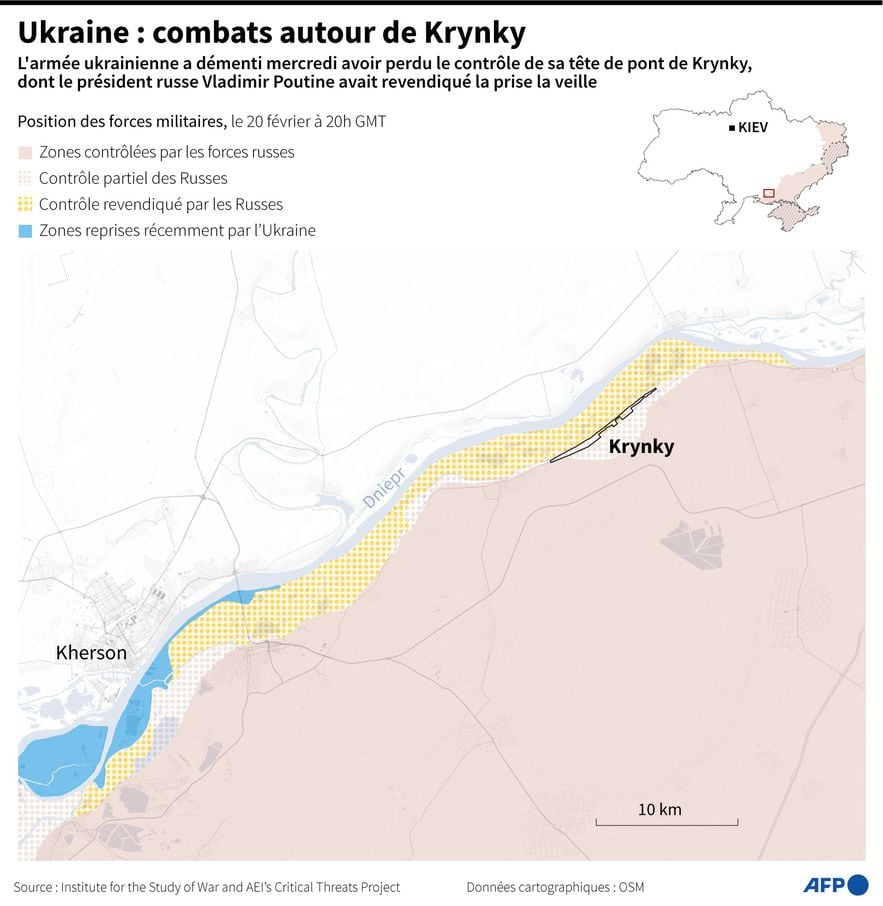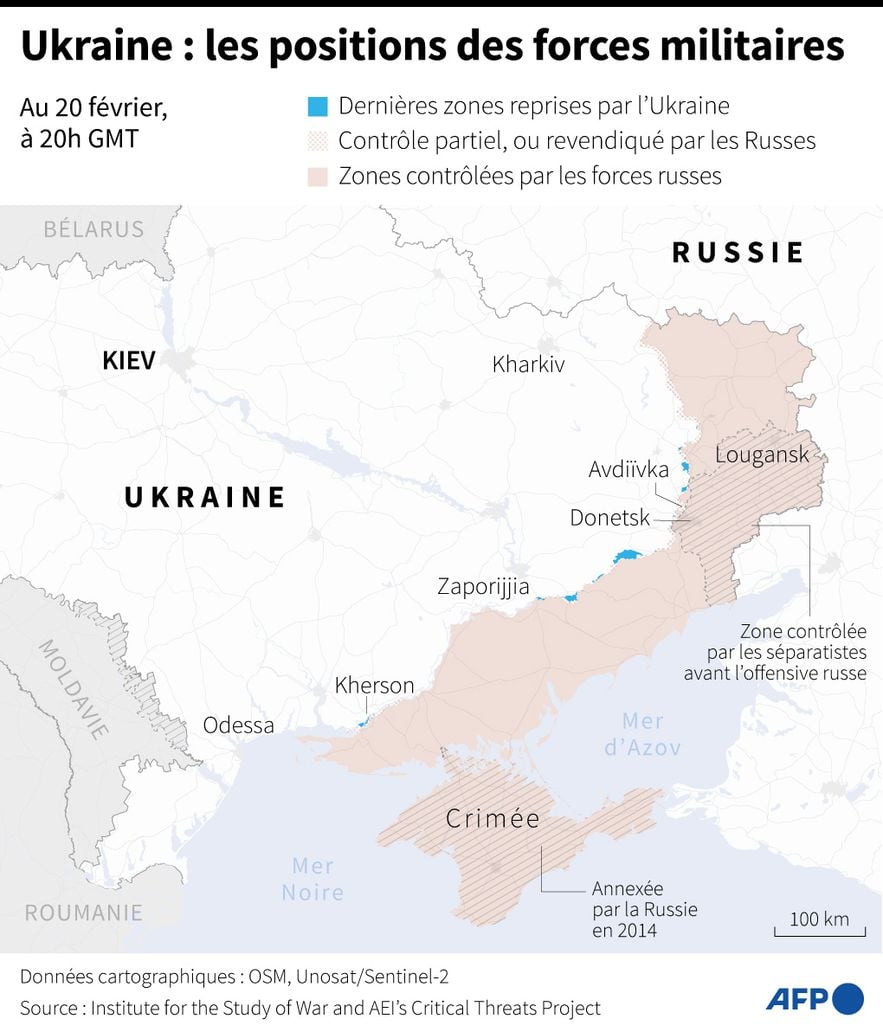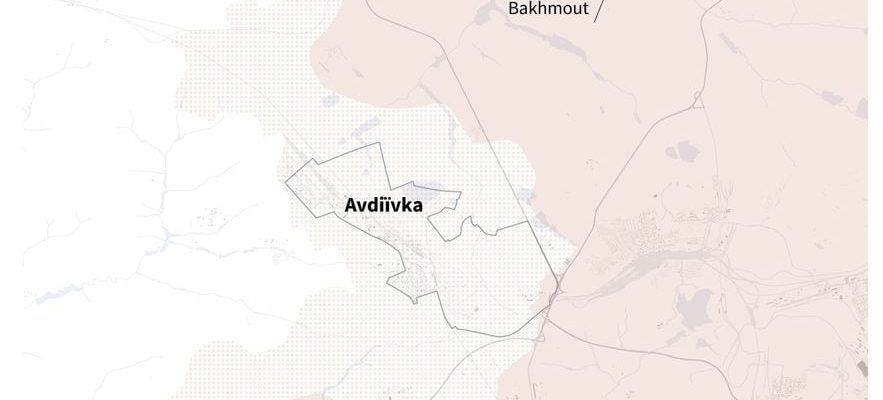This February 24, it will be two years since the Ukrainian army defended itself against the Russian invasion launched by Vladimir Putin. Two years of bitter fighting, from the first breakthrough pushed back at the gates of kyiv to the human carnage of Bakhmout, from the lost hope of the counter-offensive last summer to a new war of positions since the fall.
As the third year of war approaches, the Ukrainian army nevertheless finds itself in particular difficulty. She had to cede control of Avdiivka, this industrial city in the east of the country which she fiercely defended from the incessant assaults of the Russian army. Above all, it faces Western support that is always hesitant and insufficient. L’Express returns to the major current issues of a war which is perhaps reaching a turning point.
The uncertain outcome of the defeat at Avdiivka
What will be the impact of the defeat in the Battle of Avdiivka? While the Ukrainian army was forced to retreat last weekend from the fortified city in the east of the country, which over the months has become the new epicenter of the fighting between the two camps, the time comes for a first assessment and future consequences of this battle.
According to Oleksandr Tarnavsky, the Ukrainian general commander of the sector, 47,000 Russians were killed or wounded in four months of battle at Avdiivka, a figure impossible to verify. For comparison, Western sources estimate that since the start of the war, the Russian death toll is around 350,000 killed or wounded.
Map of the front line around the town of Avdiivka, Ukraine
© / AFP
For their part, the Ukrainian forces obviously do not communicate on the number of their victims. Yet they could also have been important. According to New York Times, the perilous retreat from Avdiivka, under fire from Russian fire and projectiles, would have resulted in the capture or disappearance of between 850 and 1,000 soldiers, according to two Ukrainian soldiers informed of the operation. Significant losses both on a human level (with the loss of experienced soldiers) and symbolically for the Kiev army, whose morale could continue to crumble after the failure of last summer’s counter-offensive, and which still faces significant difficulties in recruiting and regenerating its army.
But according to The Institute for the Study of War (ISW), which studies the conflict day by day, these figures should be taken with a pinch of salt. According to their analysts, no evidence at their disposal would confirm these massive losses, without proving that they would be impossible. Finally, the communication on the “chaotic retreat” of Avdiivka remains largely used by the Kremlin to amplify its victory and try to sow discord between the Ukrainian army and its chain of command.
The difficult Russian breakthrough beyond Avdiivka
This is a concern on the Ukrainian side. Can the Russian army continue its breakthrough after Avdiivka? In recent days, Russian strikes have been reported in the area, as kyiv’s forces are reforming their lines in nearby villages, which fear they could be the next target of attacks.
On the Ukrainian side, however, we do not believe for the moment in the hypothesis of a major Russian breakthrough. For Ukrainian deputy commander Rodion Kudriashov, cited by The Economist, the Russian army would currently not be able to continue its advance from Avdiivka, at least in the short term. The ISW reported on Monday that Russian forces would “probably have to pause operationally” before resuming their offensive from Avdiivka, or “transfer additional reinforcements from other sectors of the front.”
An analysis fueled by an observation: the capture of Avdiivka, as underlined by the majority of experts, does not constitute a strategic upheaval in the region. The industrial city, left in ruins by months of fighting, was the cemetery of a significant part of the Russian army. Enough to show American officials cited by the New York Times that Russian gains in eastern Ukraine will not necessarily lead to the collapse of Ukrainian lines. Even Russian Defense Minister Sergei Shoigu, usually not sparing in hyperboles to exaggerate his successes, has not claimed any operational advantage from the capture of Avdiivka.
For ISW experts, Russian forces have even “probably established limited and localized temporary air domination” in recent weeks in Avdiivka. This would today be highlighted and diverted by Russia as a lasting superiority in order to “present the Russian offensive in Ukraine as more and more successful”, whether to glorify as much as possible the work of Vladimir Putin less than a month from his assured re-election, or to continue to discourage the Ukrainian army.
The blur of the Battle of Krynky, on the Dnieper
In the wake of its victory at Avdiivka, the Russian army sought to mark the occasion, claiming this Tuesday the recapture of the village of Krynky, on the occupied bank of the Dnieper in southern Ukraine, where the Kiev army had difficulty building a beachhead last October.

Map of the front line around the town of Krynky, on the banks of the Dnieper, Ukraine
© / AFP
Information directly denied by the Ukrainian forces this Wednesday, while this fragile bridgehead is one of the rare advances in the summer counter-offensive, “The military and political leaders of the aggressor country announced the capture of the bridgehead on the left bank of the Dnieper River. We officially say that this information is false,” the Southern Command of Ukrainian forces said on social media. For its part, the ISW said it had not observed “visual evidence” of a Russian advance in Krynky, and available images and information suggest that Ukrainian forces maintain a “limited” beachhead in the area.
As at Avdiivka, this victory would be largely symbolic for Moscow, in order to show a dynamic Russian army on the offensive. Russian Defense Minister Sergei Shoigu thus qualified the alleged Russian capture of Krynky as the “official end of the Ukrainian counter-offensive in the summer of 2023”. But the strategy could also backfire against Moscow, “by creating expectations that its army could fail to meet”, continues the ISW.
Fighting continues in the rest of the country
“The situation is extremely difficult on several points of the front line, where Russian troops have concentrated as many reserves as possible,” Volodymyr Zelensky admitted Monday evening. Because beyond the extremely tense situations in Avdiivka and Krynky, fighting is still continuing almost everywhere on the front line. According to his daily report on Monday, February 18, the ISW estimated that “delays in Western aid are likely helping Russia launch opportunistic offensive operations in several sectors of the front line, to maintain pressure on Ukrainian forces.” Whether around Kupiansk, a town taken by Russia at the very beginning of its offensive but since recaptured by Ukraine; around Bakhmout, where the fighting still rages ; but also in the Robotyne sector, in the Zaporizhia region: the ISW highlights several front lines where the Ukrainian army could be put in difficulty by the lack of ammunition and weapons, particularly to deal with bombings Russians.

Map of areas controlled by Ukrainian and Russian forces in Ukraine as of February 20, 2024
© / AFP
Which always brings us back to the same point: can Ukraine continue to hold out without lasting and much more substantial Western support? On the Battle of Avdiivka alone, Ukrainian deputy commander Rodion Kudriashova claimed that the Russian army had eleven times greater artillery capabilities than the Ukrainian forces. In the twelve days before the city’s fall, Moscow’s forces also dropped nearly 60 massively destructive aerial bombs every day. The battle would have ended “completely differently” if the Ukrainian forces had had more equipment and ammunition, the Ukrainian soldier continued.
With American aid still frozen by Congress, and European aid deemed by many to be insufficient, the evolution of the front in the coming months will largely depend on the ability of the West to continue to support and supply weapons and ammunition. the Ukrainian army. Moscow and kyiv “are racing to rebuild their offensive capacity. If Western funds are not released, if Russia gains the advantage in one way or another, it will have the opportunity to make further progress,” explains to AFP Andrea Kendall Taylor, researcher at the Center for New American Security, based in Washington. “The dynamic has changed,” said this analyst, emphasizing that “from Putin’s point of view, 2024 is a crucial year.” It’s up to the West to prove him wrong.
